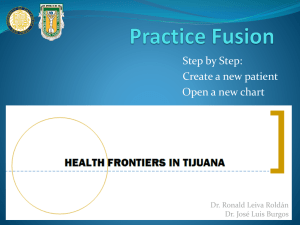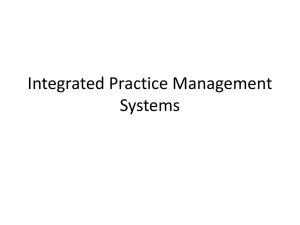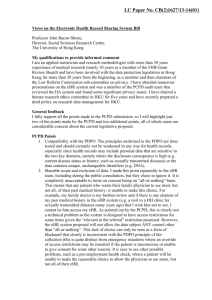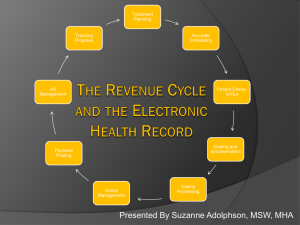Scenario-Oriented Information Extraction from Electronic
advertisement
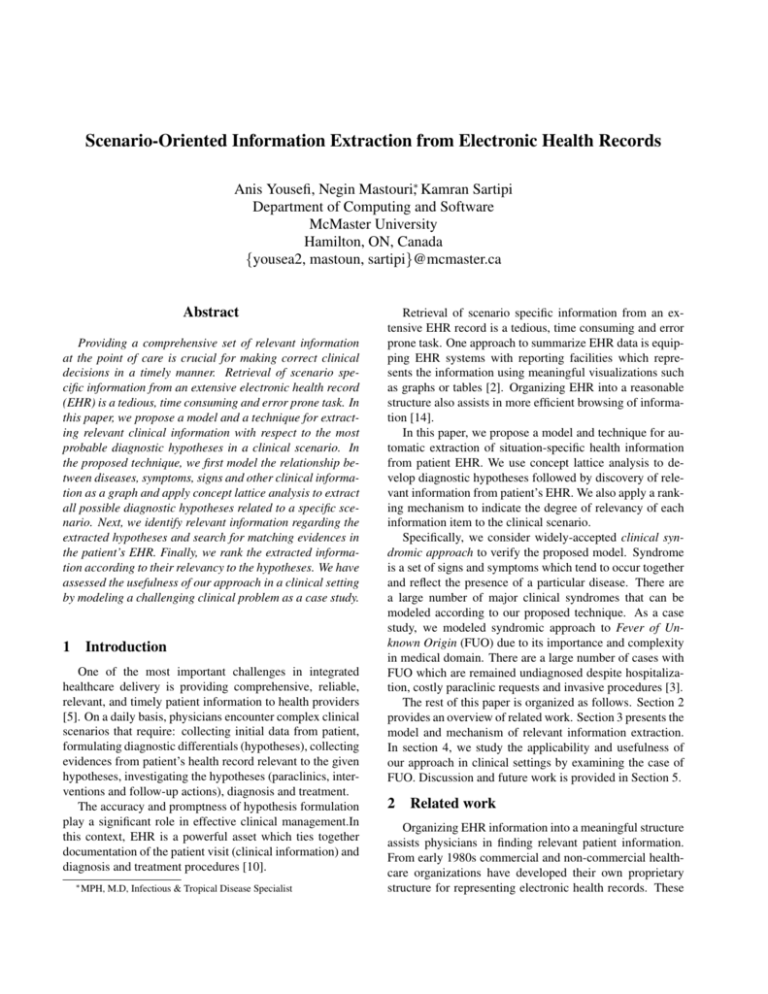
Scenario-Oriented Information Extraction from Electronic Health Records
Anis Yousefi, Negin Mastouri∗, Kamran Sartipi
Department of Computing and Software
McMaster University
Hamilton, ON, Canada
{yousea2, mastoun, sartipi}@mcmaster.ca
Abstract
Providing a comprehensive set of relevant information
at the point of care is crucial for making correct clinical
decisions in a timely manner. Retrieval of scenario specific information from an extensive electronic health record
(EHR) is a tedious, time consuming and error prone task. In
this paper, we propose a model and a technique for extracting relevant clinical information with respect to the most
probable diagnostic hypotheses in a clinical scenario. In
the proposed technique, we first model the relationship between diseases, symptoms, signs and other clinical information as a graph and apply concept lattice analysis to extract
all possible diagnostic hypotheses related to a specific scenario. Next, we identify relevant information regarding the
extracted hypotheses and search for matching evidences in
the patient’s EHR. Finally, we rank the extracted information according to their relevancy to the hypotheses. We have
assessed the usefulness of our approach in a clinical setting
by modeling a challenging clinical problem as a case study.
1
Introduction
One of the most important challenges in integrated
healthcare delivery is providing comprehensive, reliable,
relevant, and timely patient information to health providers
[5]. On a daily basis, physicians encounter complex clinical
scenarios that require: collecting initial data from patient,
formulating diagnostic differentials (hypotheses), collecting
evidences from patient’s health record relevant to the given
hypotheses, investigating the hypotheses (paraclinics, interventions and follow-up actions), diagnosis and treatment.
The accuracy and promptness of hypothesis formulation
play a significant role in effective clinical management.In
this context, EHR is a powerful asset which ties together
documentation of the patient visit (clinical information) and
diagnosis and treatment procedures [10].
∗ MPH,
M.D, Infectious & Tropical Disease Specialist
Retrieval of scenario specific information from an extensive EHR record is a tedious, time consuming and error
prone task. One approach to summarize EHR data is equipping EHR systems with reporting facilities which represents the information using meaningful visualizations such
as graphs or tables [2]. Organizing EHR into a reasonable
structure also assists in more efficient browsing of information [14].
In this paper, we propose a model and technique for automatic extraction of situation-specific health information
from patient EHR. We use concept lattice analysis to develop diagnostic hypotheses followed by discovery of relevant information from patient’s EHR. We also apply a ranking mechanism to indicate the degree of relevancy of each
information item to the clinical scenario.
Specifically, we consider widely-accepted clinical syndromic approach to verify the proposed model. Syndrome
is a set of signs and symptoms which tend to occur together
and reflect the presence of a particular disease. There are
a large number of major clinical syndromes that can be
modeled according to our proposed technique. As a case
study, we modeled syndromic approach to Fever of Unknown Origin (FUO) due to its importance and complexity
in medical domain. There are a large number of cases with
FUO which are remained undiagnosed despite hospitalization, costly paraclinic requests and invasive procedures [3].
The rest of this paper is organized as follows. Section 2
provides an overview of related work. Section 3 presents the
model and mechanism of relevant information extraction.
In section 4, we study the applicability and usefulness of
our approach in clinical settings by examining the case of
FUO. Discussion and future work is provided in Section 5.
2
Related work
Organizing EHR information into a meaningful structure
assists physicians in finding relevant patient information.
From early 1980s commercial and non-commercial healthcare organizations have developed their own proprietary
structure for representing electronic health records. These
products vary from a simple time-oriented list of medical
concepts [9, 8] to relatively sophisticated problem-oriented
[17, 9] and source-oriented [14] medical records. In timeoriented structure, patient information is categorized into
groups of events (e.g., lab results in a specific date). In
problem-oriented structure, the information is grouped under one or more problem headings: Subjective, Objective,
Assessment, and Plan (SOAP). In source-oriented structure,
the content of a record is arranged according to the method
by which the information was obtained (e.g., notes of visits,
X-ray reports and blood tests).
Most EHR systems support query-response mechanism
for information retrieval [16, 15]. In this mechanism, a domain expert is needed to specify the set of queries that care
givers would require. To find relevant information, care
givers use those predefined queries through system interfaces. Both browsing and query-response methods suffer
from the fact that user must know what he/she is looking
for and find the appropriate section or query interface to get
the information.
In [5, 6, 7] an information retrieval system is presented
which provides situation-specific EHR information related
to the current activity within the patient’s care workflow.
The primary care workflow is modeled with an ontology,
where for each activity in workflow relevant EHR headings
and linguistic degree of relevance are pre-assigned.
In [13] adding knowledge to EHR records is proposed.
This knowledge can be used by applications to provide
patient-related functionality. We extend this idea by proposing the required domain models for relevant information extraction.
3
Scenario-oriented clinical information extraction
In this section, after defining a number of terms used in
our proposed model, we discuss the scenario-oriented clinical information extraction process illustrated in Figure 1.
3.1
Definition of terms
The following terms are used in the proposed model.
Relevancy: measure of how “useful” the retrieved information is with regard to its application. In this work, we have
considered the usefulness and relevancy of the extracted information in the process of diagnosis.
Scenario: a narrative that captures the interaction between
a patient and a physician in a visit in terms of patient’s
symptoms and signs. In our approach, we represent an abstraction of a scenario as the set of symptoms and signs.
Hypothesis: a tentative explanation for the cause of a clinical scenario that can be tested by further investigation. Diseases that share the same set of signs and symptoms with a
scenario are referred to as hypotheses of that scenario.
EHR item: we represent an abstraction of EHR as a set of
(item, value, date) tuples. EHR items are symbols representing clinical manifestations, predisposing factors and comorbidities, findings in physical examinations, laboratory
information, imaging results, and other items which can be
found in the EHR.
EHR category: we group EHR items into 7 categories:
Demographic data, Past Medical History, Medications History, Allergy/Vaccination/Diet, Habitual History, Psychosocial History, Lab/Imaging/Procedure.
DiseaseAtt: a disease attribute refers to any EHR item or
sign/symptom.
Evidence: an (item, value, date) tuple from EHR which
strengthens or weakens a hypothesis.
3.2
Proposed model
The proposed model for extracting scenario-oriented
clinical information consists of the following two phases as
illustrated in Figure 1:
Phase 1 (off-line processing): the relationships between
diseases, symptoms/signs (SymSign) and EHR items are
modeled as Disease-Graph. Then, we apply concept lattice analysis to represent Disease-Graph as highly associated groups of Disease’s and SymSign’s.
Phase 2 (on-line processing): consists of the following
operations: i) extracting a set of probable hypotheses related to a specific scenario using the concept lattice analysis discussed in Phase 1; ii) indicating the set of relevant
SymSign’s and EHRiv’s from the Disease-Graph; and iii)
extracting set of matched EHRiv’s from the patient’s EHR
to discriminate among hypotheses.
3.3
Phase 1: off-line processing
The offline processing is independent of specific patient
information and is comprised of two steps as follows.
Disease-Graph modeling
A Disease-Graph, as illustrated in Figure 1(a), is modeled
as a weighted typed graph G = (V, E, W ) where the
set of vertices V is the union of Disease’s, SymSign’s, and
EHRiv’s. The set of edges E ⊆ V × V represents the relevancy of SymSign’s or EHRiv’s to the Disease’s. The set of
weights W represents the degree of relevancy of the edges
in E, where a weigh wij ∈ W is a quantity that we assign
to an edge to indicate the support of SymSignj or EHRivj in
the diagnosis of Diseasei . Weight wij is a combination of
three weights: wij = wij1 × wij2 × wij3 .
wij1 indicates the importance of each EHR category in
the process of diagnosis.
wij2 is assigned based on how much an specific SymSign
or EHRiv contributes to the likelihood of a specific hypothesis based on expert opinion.
Figure 1. Scenario-oriented clinical information extraction.
wij3 is assigned by reviewing best practice evidence
based resources such as UpToDate [3]. In this approach, we
use the available health records of patients as a source to
measure how much a specific SymSign or EHRiv is related
to a specific Disease. There are many ways to realize such
a requirement. We can use the percentage of patients with a
given symptom which have been diagnosed with a specific
disease or the percentage of patients with a given disease
which had a specific symptom in their problem lists. An
example of the first case could be: 20% of patients with
symptom s1 are diagnosed with disease d1 , and 80% of
them are diagnosed with disease d2 . An example of the
second case could be: 80% of patients with disease d1 had
symptom s1 and also 80% of patients with disease d2 had
the same symptom.
Disease-Graph partitioning
In this step, we apply concept lattice analysis on the relations between SymSign’s and Disease’s from the DiseaseGraph to generate groups of Disease’s and SymSign’ with
maximum association, as illustrated in Figure 1(b). Maximal association is a term borrowed from data mining referring to a set of objects all sharing a same set of attributes.
In our approach, Disease’s represent objects and SymSign’s
represent attributes.
In concept lattice [11], a binary relation between objects
and their attributes is represented as a lattice which provides
significant insight into the structure of the relation. Each
node in the concept lattice is a concept. A concept is a maximal association where its object set is called extent and its
attribute set is called intent. A concept lattice has the following characteristics:
• Each lattice node (i.e., a concept) is labeled with objects (Disease’s) and attributes (SymSign’s) except for
the top and bottom nodes that may be unlabeled.
• Every object has all attributes that are above it in the
lattice (directly above or separated by some links).
• Every attribute exists in all objects that are below it in
the lattice (directly above or separated by some links).
An example of concept lattice is shown in Figure 3 of the
case study in Section 4.
3.4
Phase 2: on-line processing
On-line processing refers to the process of extracting
relevant information with regard to a specific scenario. It
consists of three steps as follows.
Hypothesis discovery
In this step, we discover hypotheses related to a specific
scenario using the result of concept lattice analysis. Where,
the extent of a concept represents a set of Hypotheses and
the intent of the concept represents the set of SymSign’s
from the corresponding scenario. Figure 1(c) illustrates a
concept with extent {d5 , d9 } and intent {s5 , s10 , s14 }.
Evidence discovery
In this step, we use Disease-Graph to discover other SymSign’s and all EHRiv’s relevant to the hypotheses (diseases)
which have been discovered in the previous step. Then, we
search EHR for those (item, value, date) tuples whose
item part is the same as the item part in an EHRiv. Next,
we compare the value part of the EHR item with the value
part of the respective EHRiv. There are two possible results. In the case of a match, the EHR item supports its
respective hypothesis. In the case of a mismatch, the EHR
item weakens its respective hypothesis. We also consider
those EHRiv’s that we couldn’t find in the EHR to indicate
the need for further investigation by physician.
Figure 1(d) highlights matches with X, mismatches with
×, and unfound items with −. In this figure solid lines
represent the relationship between Disease’s and the information we already know about them (i.e. initial symptoms
and signs), dotted lines represent the information that we
need to investigate, and s indicates other symptoms and
signs that are related to the Disease.
Calculating the degree of relevancy
Degree of relevancy indicates how relevant information is to
a hypothesis. wij indicates the relevancy of information j to
hypothesis i. The likelihood of a hypothesis in a scenario is
also calculated by aggregating the weights of its supportive
evidences: wi = Σ1≤j≤m (wij )
Figure 2. Context table for FUO.
Note that we put some thresholds to translate quantitative
values to qualitative terms strong, medium-strong, medium,
mild-medium and mild.
4
Case study
We conducted a case study to indicate how our approach
can be used in a real-world health care scenario. In this section, we illustrate how relevant information are extracted
with regard to the current clinical scenario. In this case
study, we modeled Fever of Unknown Origin (FUO)1 as
an example of a major clinical syndrome. Approaching a
patient with FUO is one of the most challenging problems
in medical science, mostly because of the large number of
potential diagnoses [3, 12].
We have modeled 45 diseases and 64 common symptoms
and signs (SymSign) associated with FUO from a highly
cited medical reference by Mandell et al. [12]. Figure 2 illustrates the context table associated with our case study and
represents relations between diagnostic hypotheses in FUO
and their associated symptoms and signs. We employed the
Concept Explorer tool [1] to generate and illustrate the concept lattice of different hypotheses and their corresponding
symptoms and signs into 499 concepts.
In the following, we provide a sample clinical scenario
to assess the proposed model: A 68-year-old Spanish female
presented with anorexia, malaise, non-productive cough,
night sweats, chill, and daily fever (temperature, 38.3◦ C39.5◦ C) from 4 days ago. She recently moved to Canada
and spoke English with difficulty and was not cooperative
in giving a precise history. She was brought to clinic by
her neighbor who was not aware of her past medical history, her medications and contact with animals or ill people. In her first visit, cardiovascular, respiratory, and breast
examinations were unremarkable. She was diagnosed community acquired pneumonia by family physician who prescribed antibiotic medication for her. Over the following
weeks her fever persisted. She was referred to specialist for
1 FUO is defined as a body-temperature higher than 38.3◦ C that lasts
more than 3 weeks with no obvious source despite appropriate medical
investigations.
Figure 3. The concept associated with the
scenario.
further investigation of FUO.
The set of symptoms and signs of the patient in the above
scenario is {anorexia, malaise, non-productive cough, night
sweats, chill, fever}. Using the concept lattice of FUO we
identified {Tuberculosis, Sarcoidosis, Recurrent Pulmonary
Embolism, Lymphoma} as possible diseases for the patient.
Figure 3 highlights the concept associated with the scenario.
We consider the following weights for “DiseaseAtt to
Disease” relations:
w1 is weighted 0.7 for each of: past medical history
of immobilization, surgery in previous three months, and
diabetes. This weight is assigned according to Bates [4],
where patient’s history is the most important element of
EHR contributing more than 70% to develop proper hypotheses. Physical examination contributes an additional
20-25%; and, laboratory testing contributes less than 10%.
w2 is assigned based on expert’s opinion. For example,
in this case 0.7 is assigned to immobilization, 0.8 to surgery
and 0.7 to diabetes.
w3 is assigned according to evidence based resources
(meta analysis results). For example, in our case 0.6 is assigned to immobilization, 0.6 to surgery and 0.4 to diabetes.
Using the proposed ranking system, the ranks of the hypotheses in our scenario is: 1) Recurrent Pulmonary Emboli
(strong); 2) Lymphoma and Tuberculosis (medium-strong);
3) Sarcoidosis (medium);
At this point, we use Disease-Graph to discover the complete set of DiseaseAtt information related to the diseases
in our set and their required values. Figure 4 illustrates a
part of these DiseaseAtt information and the result of their
matching against EHR.
Result for Recurrent Pulmonary Emboli is illustrated in
table 1. For lack of space we have omitted the results of
other hypotheses in this list.
As you see, this is the set of relevant information that
physicians wish to see from EHR. This representation trig-
Table 1. Results for Pulmonary Embolism
Hypothesis
Pulmonary Embolism
(Strong)
Supporting Evidences
Age (strong), Diabetes (strong),
Surgery(strong),
Immobilization(strong)
Weakening Evidences
Normal ECG(mild),
Normal CXR (medium)
Unfound Items
D-Dimer test (strong),
Lung perfusion Scan (strong)
Pleuritic chest pain (strong)
potentials and feasibility. Also we intend to improve our
ranking system by introducing dynamic edge weights.
References
Figure 4. A part of disease-graph.
gers clinical memory, permitting the related knowledge to
become accessible for reasoning. It helps physicians to
be aware of clinical consequences, predisposing conditions,
and other signs and symptoms that are neglected or will develop in the future. Moreover, it directs physicians to request essential cost-effective labs, images, and procedures
and update EHR.
According to the information above, recent surgery and
immobilization in the patient’s EHR are two strong evidences for the diagnosis of Pulmonary Embolism.
5
Discussion and future work
In this paper, we presented a model and a technique to
extract situation (scenario) specific information from EHR
for the purpose of diagnosis. We provide a tailored view of
EHR by dynamically grouping its information into relevant
or irrelevant based on the current clinical scenario of the
patient problem. The scenario, as a core, directs us to collect
additional supporting or weakening evidences form EHR.
Unlike related approaches, the selection of what is relevant is done dynamically based on the internal knowledge
of disease-attribute relations and extraction of hypotheses
for a specific situation. Moreover, we differentiate between
the information which support a hypothesis, the information which are against a hypothesis and the information we
should investigate in order to decide about a hypothesis.
Our ranking is also more specific than those we have seen
in the related approaches, where the ranking is static. In
our work, the assignment of a rank to an information item
depends on it’s context (the hypothesis to which it belongs).
As a next step in our approach we continue our simulation with a group of clinicians to clearly show our methods’
[1] Formal
concept
analysis
toolkit
version
1.3.
http://sourceforge.net/projects/conexp.
[2] HL7 EHR-S records management and evidentiary support
functional profile. www.hl7.org.
[3] Uptodate online version 17.1. http://www.uptodate.com/.
[4] B. Bates. Bates Guide to Physical Examination and History
Taking,Barbara bates. Churchill Livingstone, 2007.
[5] E. Bayegan and O. Nytro. A problem-oriented, knowledgesystem. In Proc. of MIE2002, pages 272–276, 2002.
[6] E. Bayegan, O. Nytro, and A. Grimsmo. Ontologies for
knowledge representation in the computer-based patient
record system. In Proc. of ICTAI 2002, pages 114–121.
IEEE Computer Society, 2002.
[7] E. Bayegan and S. Tu. The helpful patient record system:
Problem oriented and knowledge based. In Proc. of AMIA
2002 Annual Symposium, pages 36–40, 2002.
[8] L. J. Bird, A. Goodchild, and H. Sue. Describing electronic
health records using xml schema. In XML Asia Pacific, 2000.
[9] K. Hayrinen, K. Saranto, and P. Nykanen. Definition, structure, content, use and impacts of electronic health records:
A review of the research literature. Int. Journal of Medical
Informatics, 77:291–304, 2008.
[10] R. L. Koeller. It applications in healthcare: The electronic
medical record. Master’s thesis, University of Maryland,
European Division, Bowie State University, 2002.
[11] S. Kuznetsov and S. Obiedkov. Algorithms for the construction of concept lattices and their diagram graphs. Lecture
Notes in Computer Science, 2168:289–300, 2001.
[12] G. L. Mandell, J. Benett, and R. Dollin. Principles and Practice of Infectious Diseases. Churchill Livingstone, 2004.
[13] D. Ammon et. al.
Developing an architecture of a
knowledge-based electronic patient record. In ICSE 08:
Proc. of the 30th int. conference on Software engineering,
pages 653–660, 2008.
[14] H. J. Tange et. al. Medical narratives in electronic medical
records. Int. Journal of Medical Informatics, 46(1):7–29,
1997.
[15] M. Croitoru et. al. Conceptual graphs based information retrieval in healthagents. In CBMS ’07: Proc. of the Twentieth
IEEE Int. Symposium on Computer-Based Medical Systems,
pages 618–623. IEEE Computer Society, 2007.
[16] T. Austin et. al. Implementation of a query interface for a
generic record server. Int. Journal of Medical Informatics,
77(11):754–64, 2008.
[17] L. Weed. Medical records that guide and teach. The New
England Journal of Medicine, 278(12), March 1968.




